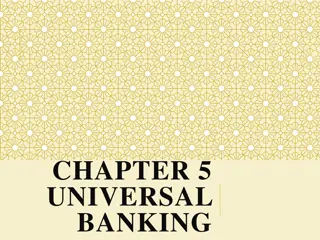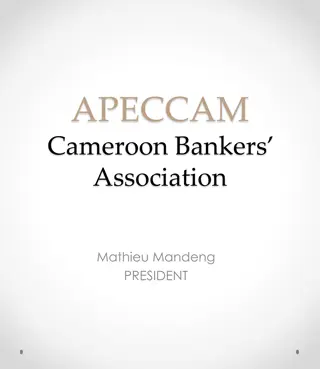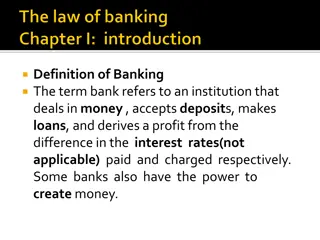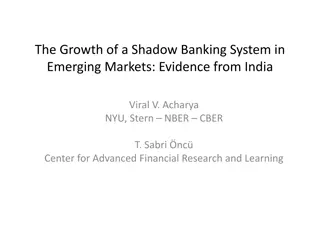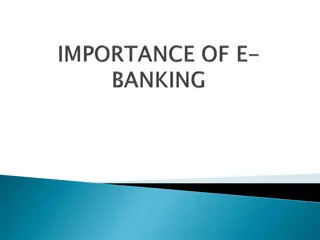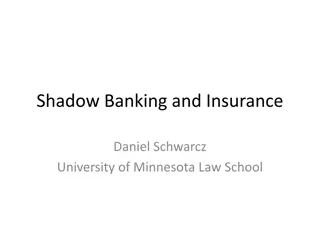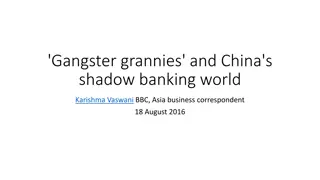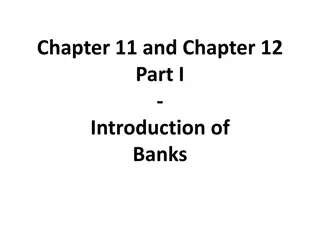EU vs. Canada: Shadow Banking Regulation Disparity
The EU is actively regulating shadow banking post-2008 financial crisis, while Canada has been relatively quiet despite both being FSB members. The research delves into the FSB's recommendations, understanding shadow banking, and analyzing the regulatory actions of the EU and Canada.
Download Presentation

Please find below an Image/Link to download the presentation.
The content on the website is provided AS IS for your information and personal use only. It may not be sold, licensed, or shared on other websites without obtaining consent from the author.If you encounter any issues during the download, it is possible that the publisher has removed the file from their server.
You are allowed to download the files provided on this website for personal or commercial use, subject to the condition that they are used lawfully. All files are the property of their respective owners.
The content on the website is provided AS IS for your information and personal use only. It may not be sold, licensed, or shared on other websites without obtaining consent from the author.
E N D
Presentation Transcript
A Game of Shadows: Why Does the EU Attempt to Regulate Shadow Banking while Canada Does Not? Sebastien Labrecque School of Political Studies Nassiba Idebdou Graduate School of Public and International Affairs
BACKGROUND INFORMATION The 2008 financial crisis exposed problems and risks associated with various sectors and actors of the global financial system which had remained hidden until then. Example: shadow banking and the potential systemic risks associated with it. First set of more pressing financial reforms after the crisis mostly targeted banks, but shadow banking eventually got on the agenda on the Financial Stability Board (FSB). The European Union (EU) began to work on the issue of shadow banking relatively early. While usually at the forefront of international financial regulation, Canada has been surprisingly quiet on the issue and has yet to formally implement the FSB s recommendations.
RESEARCH QUESTION Why is the EU trying to regulate shadow banking while Canada is not, in spite of the fact that they are both members of the Financial Stability Board?
OUTLINE What is shadow banking? The FSB s recommendations The EU and shadow banking Canada and shadow banking Conclusion
WHAT IS SHADOW BANKING?(1/2) Financial Stability Board: credit intermediation involving entities and activities (fully or partially) outside the regular banking system (Financial Stability Board 2013a, iv). Broadly defined, shadow banking includes entities such as: non-bank loan originators; private-label securitizers; investment banks; structured investment vehicles; hedge funds; various finance companies; different types of funds (private equity, mutual, pension, investment, etc.) (Blinder 2013, 60).
WHAT IS SHADOW BANKING? (2/2) Shadow banking s main markets encompass: (Blinder 2013, 60) Asset-backed securities (including mortgage- backed) Commercial paper Repurchase agreements (repos) Derivatives
THE FSBS RECOMMENDATIONS (1/3) G20 Seoul Summit 2010 G20 Cannes meeting 2011 2013: FSB published three final policy documents An Overview of Policy Recommendations; Policy Framework for Addressing Shadow Banking Risks in Securities Lending and Repos; Policy Framework for Strengthening Oversight and Regulation of Shadow Banking Entities. Using an activity-based approach, the documents focus on five areas for which shadow banking can present potential systemic risks if not regulated
THE FSBS RECOMMENDATIONS (2/3) The five areas identified by the FSB: to mitigate the spill-over effect between the regular banking system and the shadow banking system; to reduce the susceptibility of money market funds (MMFs) to runs ; to assess and align the incentives associated with securitisation; to dampen risks and pro-cyclical incentives associated with securities financing transactions such as repos and securities lending that may exacerbate funding strains in times of market stress; and to assess and mitigate systemic risks posed by other shadow banking entities and activities. (Financial Stability Board 2013b, i)
THE FSBS RECOMMENDATIONS (3/3) What is next? Member states can begin the implementation of the recommendations Progress will be monitored by the FSB and reported at the G20 Brisbane Summit this Fall Peer review starting in 2015
HOW DID SHADOW BANKING GET ON THE EU S AGENDA? Spring 2012: Green Paper and a public conference on shadow banking are organized by the European Commission. European Parliament, via the own-initiative procedure , also took a closer look at shadow banking in 2012 October 2012: Final report of the High-level Expert Group on reforming the structure of the EU banking sector ( Liikanen Report ) 2013-2014: Roadmap and first set of proposals for a regulation
2 PROPOSALS FOR A REGULATION Proposal for a Regulation of the European Parliament and of the Council on Money Market Funds (2013) Proposal for a Regulation of the European Parliament and of the Council on reporting and transparency of securities financing transactions. (2014)
ECs PROPOSALS VS FSBs RECOMMENDATIONS In line with certain areas of focus of the FSB (MMF, securities financing transactions) Some discrepancies (especially on MMFs) EC s constant net asset value MMFs versus FSB s variable net asset value MMFs 3% liquidity buffer
Why has the EU been so proactive on the issue of shadow banking? EU started working on shadow banking before the FSB was done writing its final policy documents Canadian authorities were still officially waiting in 2013 for the reforms to be agreed at the international level before acting and deciding how (and which) measures targeting shadow banking should be implemented (Lane 2013, 8). Three reasons Size of the shadow banking sector in the EU Shadow banking system and the rest of the financial system are highly interconnected Stricter rules for the banking industry could lead to a move to the shadows The EU and its global leadership in implementing its G20 commitments (European Commission 2012, 2)
OPPOSITION TO THE PROPOSALS (1/2) The regulation of MMFs has drawn the most attention so far. Most of the MMFs operating in the EU are based in France, Ireland and Luxembourg. France and Germany VS Ireland, Luxembourg and the MMF industry Explaining the position of France on MMF. Three factors: Size of MMFs vis- -vis total banking system Variable net asset value MMFs in France Recent history tends to show that financial interests in France do not have the same influence on the government than in other countries like the United States and the United Kingdom.
OPPOSITION TO THE PROPOSALS (2/2) The United Kingdom in the debate on shadow banking Ever since the regulatory push that followed the 2008 crisis, the UK has proven reluctant at times in its efforts to enhance the regulation of financial activities and entities. 2009: UK s opposition to the EC directive on Alternative Investment Funds Managers Since this event, the position of the UK on shadow banking has been relatively nuanced. British government claims to be fully supportive of the work of the FSB on improving the oversight and regulation of shadow banking (Leadsom 2014, 10). However, it is still possible to see that the United Kingdom remains very close to the financial sector s positions on some specific issues, such as liquidity buffers for MMFs and securities financing transactions
SHADOW BANKING IN CANADA 40% of traditional banking sector; Using an activities-based approach, it can be divided in 5 categories; Repos 10% Private-Label Securitization 10% MMF 5% Other 20% NHA BA/CP 15% MBS/CMB 60% Source: Gravel, Grieder and Lavoie 2013, 57, Bank of Canada.
SHADOW BANKING IN CANADA Why is it important Between 2007 and 2012: Important increase in mortgage-backed securities; Shift away from private-label securitizations; Increase in the growth of credit lending activities; The growth of repo market $48 billion and $75 billion during the third quarter of 2012
CANADAS LEADERSHIP IN FINANCIAL REGULATION IN THE WAKE OF THE 2008 CRISIS Strong economic performance Quality of regulatory system and regulators Full compliance with Basel III ahead of time
4 FACTORS TO EXPLAIN CANADAS RESPONSE TO THE FSB-EU PROPOSALS Canadian Market-Based Finance Sector Canadian Banking System Financial Regulation Proactivity Securitization Transactions
1 CANADIAN BANKING SYSTEM Concentration: Big Five absorbed many sources of systemic risk through time Risk kept under the regulatory umbrella and tight enforcement of regulations by OSFI Less non-bank financial intermediaries than in the EU
2 CANADIAN MARKET-BASED FINANCE SECTOR (MBF) Expansion of MBF in the last 15 years Good performance in most of securitization markets despite the crisis (i.e. MBS, repos) Canadian financial infrastructure helped sustain the adverse impact of the crisis
3 FINANCIAL REGULATION Major reform after the crisis in two riskier markets: repos and mortgage-backed securities Limit on government lending exposure (securities guaranteed by the government cannot be used as collateral in securities transactions) Increase in Bank of Canada s legal powers on repo markets and over-the-counter derivatives
4 SECURITIZATION TRANSACTIONS Support to the sector rather than complete restriction i.e. repo market and CPPs Risk measurement mechanisms to mitigate systemic risks High leverage ratios in place Higher risk-based capital requirements for liquidity lines Continuous efforts to collaborate domestically
WHY THE CANADA-EU PARTNERSHIP IS IMPORTANT Regulatory arbitrage between countries can lead to competitive imbalances Multiple burdens on banks Allow for similar reforms in shadow banking Jurisdictions are not immune to the vulnerabilities of the global markets
REDUCING THE RISKS OF SHADOW BANKING - WHAT IS NEEDED Credit Rating Agencies Oversight Consistency in evaluating financial instruments Fostering confidence between nations Money Market Mutual Funds Liquidity levels of assets Maturity of investment portfolios
WHATS NEXT FOR CANADA Focus on monitoring of expanding new securities (CPPs and ACBPs) Limit the risks of rising demands of credit lending via shadow banking activities Look at non-bank entities to complement the analysis of market-based credit-intermediation activities
CONCLUSION Shadow banking has been on the international agenda since 2010. It is now up to national governments to implement the recommendations that were made by the FSB in 2013. EU moved early on the issue. To the second part of our research question (i.e. why is Canada not regulating shadow banking despite its FSB membership ), we find that Canada has regulated some aspects of shadow banking (before and after the crisis). Some aspects of the financial architecture and the banking system in Canada did not require further regulations after the crisis. Canada will have to collaborate with the EU (and others) to prevent the fragmentation of the global financial system (and the consequences it would have on Canadian financial actors)
THANK YOU THANK YOU

 undefined
undefined








